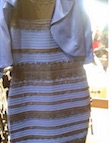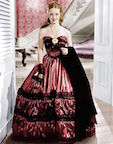February 27, 2015
If you spend any time on the Internet at all (and if you’re reading this blog, you obviously do), you probably heard about the viral dust-up that swept the web about what color the dress on the left is. Gold and white? Black and blue? With the speed of a keyboard, passionately held positions were quickly staked out arguing both answers. Almost as quickly, and almost just as inevitably, other posters began dismissing the whole issue as trivial and yet another example of the shallowness of net culture. Who cares about the color of a dress? What is wrong with people these days? Why is everyone so up in arms about this?
Well, that’s a good question, actually. It’s clear that just saying people shouldn’t get so worked up about the color of the dress doesn’t mean they won’t. The question of why we have such an emotional reaction (and whether we think we should have such a reaction, I’d be willing to bet you had one) to someone insisting that the dress is really black and blue when we see it as white and gold (or vice versa) goes right to the heart of the cinema experience. Invoking the old instructor’s excuse of the teachable moment, I’d like to use this latest micro-squabble to offer a few examples of how vision and color have worked in the evolution of our screen experiences of the movies as a way of suggesting why we the question of “what color is this dress” provokes such strong feelings in us.
We can start by directing that same question to the dress on the right above, being worn by the great Bette Davis in a publicity still for the 1938 William Wyler classic Jezebel. How would you describe the color? Red? Pink? Or something more exotic like carmine or maroon? Here’s an answer from the movie itself, featuring Henry Fonda as Pres, a leading member of New Orleans high society in the years before the Civil War, who is engaged to Davis’s title character of Julie Marsden. In this scene, Julie shows off her new dress—and a bit of antebellum punk attitude—to her scandalized fiancée:
So it’s a red dress. But the movie version of the dress is in black and white. Do we only know the dress is red because Pres helpfully tells us so in the dialogue, or do we actually begin to see the dress as red? My question gets at maybe the most global answer to the question of why we care about the color of a dress: we don’t, actually. What’s being challenged is not really a description of a dress but our very sense of reality, as in this typical comment: “if that’s not gold my entire life has been a lie.” We are visually-oriented creatures living in a visually-oriented culture where “seeing is believing.” While we can measure wavelengths of light in an empirical way, “color” really refers to our how our human brains process the electrical impulses produced by these wavelengths stimulating the retinas in our eyes. In other words, color is a mental phenomenon. It’s not random (our brains share similar structures with each other), but color perception is a lot more complicated than just registering the “real” color of a dress. “What color is this dress” really turns into “what color do you see in this dress.”
All visual artists, including cinema artists, don’t simply present colors for us to see but create experiences that produce the impression of color. The filmmakers who made Jezebel were faced with the challenge of making us “see” a red dress in a “black and white” movie. In fact, since the earliest days of cinema filmmakers working in what we call “black and white” have experimented with a wide range of colors to create visual effects in what was supposedly a two-color format. Cinematographers, set and costume designers, and directors quickly figured out that different colors from across the spectrum would influence the (much more than fifty) shades of grey that define black and white. What comes across as a collection of “dark” and “light” dresses in a movie, for example, may have involved a riot of blues, reds, and yellows on the film set. In the case of Jezebel, the filmmakers determined that a rust color would produce a black and white experience that would come across as “red” to movie audiences.
Even the difference between “black and white” and “color,” categories that have become standard in our screen experiences of the movies, is illusory; obviously, “black and white” are also “colors,” and as I mentioned above, black and white is really a festival of beautiful greys. Unless, of course, it’s a festival of beautiful browns. In The Wizard of Oz, Dorothy’s journey from Depression-era Kansas to the magical land of Oz is signaled through a famous transition from sepia tone (we might call this “brown and white”), a color associated in the 1930s with 19th century photography, to fabulous Technicolor as Dorothy opens the door of her displaced farmhouse and steps into the city of Munchkins. How did the filmmakers accomplish this astonishing effect, moving from brown and white to color? The answer is they didn’t. The entire door opening sequence is in “color”; they just painted the interior of the house in “brown and white,” and underlit Judy Garland as Dorothy so that we don’t perceive the blue in her dress until she steps into the fully lit set of Oz:
So what color is Dorothy’s dress in this scene? Most viewers would say they see the dress transform from brown and white to blue and white, even though it’s the same dress throughout. There was no Tumblr, Twitter, or BuzzFeed in 1939, or else they could have had the same fun teasing viewers about the color of Dorothy’s dress as with the gold and white (or is it black blue) dress above. And the visual experience of The Wizard of Oz is the most famous example of how the meaning of color experiences is cultural through and through, as we are meant to understand the sepia tone of the first and last sections of the movie as more “realistic” than the Technicolor section. In many ways, we have maintained that bias, literally and figuratively “seeing” black and white as more “serious” and “realistic” than color. So what color is the dress? Whatever you say, you’re probably right!


